Shallow non-inversion tillage associated with improved soil health in Prince Edward Island potato production
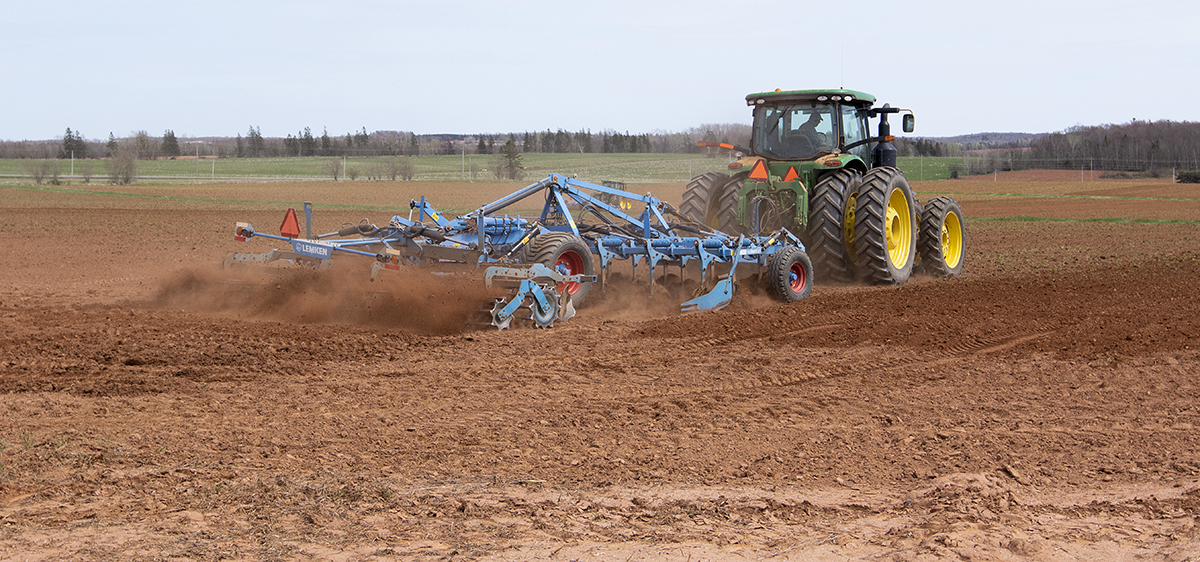
In Canada, Prince Edward Island (PEI) is one of the leading provinces for potato production, growing 85,300 acres (34,100 ha) and producing 25,930 million cwt (1.2 million Mt) of potatoes in 2024. Many producers are moving away from use of the moldboard plow and are investing in non-inversion shallow till implements, often referred to as performing “vertical tillage” or “residue tillage.” The implements till less deeply than the plow, mixing the top 6 to 8 inches of soil rather than inverting it. Given this change in tillage practices in PEI, scientists at Agriculture and Agri-Food Canada devised a research project to better understand how shallow non-inversion tillage practices compared side-by-side in commercial fields compared with traditional moldboard plowing practices. Their objective was to compare both tillage regimens in terms of impact on soil health metrics, soil moisture, potato petiole nitrate concentration, and potato yield and quality metrics. Earn 0.5 CEUs in Soil & Water Management by taking the quiz for the article.
Prince Edward Island (PEI) is known for many things (Anne of Green Gables, warm sandy beaches, delicious seafood, etc.), but two of the province’s most well-known attributes are its iron-rich red soil (primarily sandy loam) and a large, vibrant potato industry. In Canada, PEI is one of the leading provinces for potato production, growing 85,300 acres (34,100 ha) and producing 25,930 million cwt (1.2 million Mt) of potatoes in 2024 (Statistics Canada, 2024). Growing potatoes requires tillage, and historically this meant considerable use of moldboard plows to invert the top 8 to 10 inches of soil to prepare a seedbed of loose soil for planting and hilling.
A shift from moldboard to non-inversion shallow till
In recent years, many producers have been moving away from the moldboard plow for primary tillage. While the traditional plow makes a loose seedbed and is associated with reduced weed pressure, it has been increasingly associated with negatives relating to soil health. As most moldboard plowing is done in the early spring and late fall under moist soil conditions, it can contribute to formation of compacted soil layers (plow pans) (Carter et al., 2005). In addition, moldboard plowing is associated with the destruction of stable soil aggregates as well as increased mineralization of soil organic matter, both of which are detrimental to the water-holding capacity of soils (Carter et al., 2009). In Prince Edward Island, where the use of irrigation is not widespread, maintaining and improving the ability of soil to retain moisture is important, especially in a high-value crop like potatoes.
Instead of the moldboard plow, many producers are investing in non-inversion shallow till implements, often referred to as performing “vertical tillage” or “residue tillage.” The implements till less deeply than the plow, mixing the top 6 to 8 inches of soil rather than inverting it. They also tend to leave more residue at the soil surface, helping to mitigate against soil erosion. According to a recent survey by the PEI Potato Board, almost 50% of potato acres now employ these types of vertical tillage machines (Barrett, 2023). Additionally, the use of vertical tillage implements with mounted seeder boxes allow farmers to seed cover crops with one-pass, saving both time and expense.
In a meta-analysis of previous research comparing moldboard plowing with vertical tillage, soil test concentrations for potassium (K) and magnesium (Mg) were significantly higher in the vertical tillage; this makes sense, as the top horizon of soil is not flipped over and is instead mixed through the soil profile. There was also a trend showing a slightly higher level of soil pH in the reduced-tillage treatments, and marketable potato yield was significantly higher in the reduced-tillage treatment in two of three reviewed studies (Barrett, 2018).
Given this change in tillage practices in PEI, Dr. Judith Nyiraneza and colleagues at Agriculture and Agri-Food Canada devised a research project to better understand how shallow non-inversion tillage practices compared side-by-side in commercial fields compared with traditional moldboard plowing practices. Their objective was to compare both tillage regimens in terms of impact on soil health metrics, soil moisture, potato petiole nitrate concentration, and potato yield and quality metrics. This research was conducted from 2019 to 2022 in a total of 14 commercial potato fields in Prince Edward Island. For the purposes of this study, trial fields had half of the field moldboard plowed (MP) to a depth of 9–12 inches (22.5–30 cm) and half of the field tilled with shallow non-inversion tillage (“vertical tillage”) to a depth of 6–12 inches (15–30 cm). The results of this research were recently published in the American Journal of Potato Research (Nyiraneza et al., 2024).
Soil health metrics and potato yield, quality
With relation to soil health metrics, vertical tillage treatments increased soil respiration by 26% compared with moldboard plowed treatments. Vertical tillage also increased biological nitrogen availability (BNA) by 20%, and this was statistically significant in three out of four years. There was also positive, yet statistically non-significant, trends observed for active carbon (up 9%) and soil aggregate stability (up 8%) in favor of vertical tillage. However, soil moisture levels were higher at 8 inches (20 cm) in three out of four years in the moldboard plow treatments. It was unexpected to see higher soil moisture levels in the moldboard plow treatments; however, it should be noted that soil moisture was taken at one depth (8 inch/20 cm), which is approximately the depth that plant residues would be deposited by the moldboard plow.
There was no statistically significant difference in marketable yield or potato quality between the two tillage regimens. However, the research team did observe that marketable yield was positively correlated with active carbon, aggregate stability, and soil moisture levels. It is likely that inconsistent yield response can be attributed to site-specific differences such as the amount, quality, and management of crop residues as well as environmental factors (temperature and precipitation).
Biological nitrogen availability (BNA) was the most responsive metric to treatment in this study with BNA also having a strong relationship with soil respiration. This indicates that soil microorganisms are driving soil nitrogen mineralization and that this mineralization is higher under shallow-tillage practices.
Soil resilience and labor, fuel savings
While there was limited evidence of short-term yield improvement linked to the use of shallow non-inversion tillage equipment, there was sufficient evidence of improvements in soil health metrics to indicate that long-term movement to a reduced-tillage regimen may help improve soil health, thereby making soils more resilient during times of stress, such as drought. Improving soil health is a long-term process, often requiring multiple crop rotations to clearly identify improvement. Nonetheless, there are enough positive trends evident from this research to encourage producers to move toward shallow non-inversion tillage without fear of reduced yields.
In addition, producers report that vertical tillage requires less labor and less fuel per acre than moldboard plowing, providing economic advantages that go beyond agronomic performance. The research team recommends that additional research that spans multiple growing seasons would be useful to better understand both the short and long-term effects of a reduced tillage regimen in potato production.
Acknowledgments
The research team would like to thank the Prince Edward Island potato farms who participated in this on-farm research as part of the Living Labs Atlantic initiative.
References
Barrett, R. (2018). Measuring the effects of residue tillage equipment in Prince Edward Island: A review of recent field-scale research. https://peipotatoagronomy.com/wp-content/uploads/2018/08/PRT-Extension-Document-Aug18.pdf
Barrett, R. (2023). 2023 cover crop and sustainability survey results. Prince Edward Island Potato Board. http://www.peipotatoagronomy.com/reports/
Carter, M. R., Holmstrom, D., Sanderson, J. B., Ivany, J., & DeHaan R. (2005). Comparison of conservation with conventional tillage for potato production in Atlantic Canada: crop productivity, soil physical properties and weed control. Canadian Journal of Soil Science, 85, 453–461.
Carter, M. R., Sanderson, J. B., & Peters, R. D. (2009). Long-term conservation tillage in potato rotations in Atlantic Canada: potato productivity, tuber quality and nutrient content. Canadian Journal of Plant Science, 89, 273–280.
Nyiraneza, J., Fraser, T.D., Murnaghan, D., Matheson, J., Arnold, S., Stiles, K., Chen, D., Peters, R., Khakbazan, M., & Barrett, R. (2024). Primary non-inversion shallow tillage versus moldboard plowing prior to growing potatoes: short-term impacts on potato yield and soil properties in Eastern Canada. American Journal of Potato Research,101, 337–355.
Statistics Canada. (2024). Area, production and farm value of potatoes. Table 32-10-0358-01. https://www150.statcan.gc.ca/t1/tbl1/en/tv.action?pid=3210035801
Self-study CEU quiz
Earn 0.5 CEUs in Soil & Water Management by taking the quiz for the article at https://web.sciencesocieties.org/Learning-Center/Courses. For your convenience, the quiz is printed below. The CEU can be purchased individually, or you can access as part of your Online Classroom Subscription.
Non-inversion shallow till
a. inverts the top 8 to 10 inches of soil.
b. is also known as residue tillage.
c. is associated with reduced weed pressure.
d. is associated with increased mineralization of soil organic matter.
In a meta-analysis of previous research, which of the following were found to be lower with vertical tillage compared with moldboard plow?
a. Potassium.
b. Marketable potato yield.
c. Soil pH.
d. None of the above.
In the study by Dr. Judith Nyiraneza and colleagues, which of the following was increased by 20% in vertical tillage treatments compared with moldboard plowed treatments?
a. Active carbon.
b. Soil aggregate stability.
c. Soil respiration.
d. Biological nitrogen availability.
Soil moisture levels were higher at
a. 8 inches in moldboard plow treatments in three of four years.
b. 12 inches in moldboard plow treatments in all years.
c. 8 inches in vertical tillage treatments in two of four years.
d. 12 inches in vertical tillage treatments in one year.
Of this study, the authors concluded that soil microorganisms were driving soil nitrogen mineralization, and this was mineralization was higher under shallow-tillage practices.
a. True.
b. False.
Text © . The authors. CC BY-NC-ND 4.0. Except where otherwise noted, images are subject to copyright. Any reuse without express permission from the copyright owner is prohibited.








